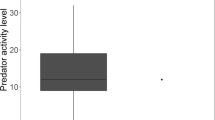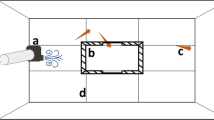Abstract
Chemical cues from piscivorous fish and prey alarm substances often cause rapid fright responses in prey. However little is known of how piscivore-related chemical cues affect prey behaviour over periods longer than a few hours. Here we have investigated how chemical cues from piscivorous northern pike, Esox lucius, affect habitat choice and diel activity of crucian carp, Carassius carassius, over an extended period 11 days. At the beginning of the experiment control fish were nocturnal while fish in the pike cue treatment were aperiodic. After 11 days, control fish had become more strongly nocturnal and displayed two activity peaks during early and late night whereas fish in the pike cue treatment were still aperiodic with no activity peaks. Habitat choice was aperiodic in both treatments throughout the experiment. In both treatments, more fish were found in the vegetation zone than in the open habitat. This was most pronounced when pike cues were present. These results demonstrate that short-term anti-predator responses to chemical cues from predators can translate into long-term adjustments of diel periodicity. Further, the results did not support the idea that crucian carp should switch to nocturnal activity in response to visually hunting predators. Control fish were nocturnal and chemical cues from pike did not make this pattern more pronounced.
Similar content being viewed by others
References
Brönmark, C. & J.G. Miner. 1992. Predator-induced phenotypical change in body morphology in crucian carp. Science 258: 1348–1350.
Brönmark, C. & L.B. Pettersson. 1994. Chemical cues from piscivores induce a change in morphology in crucian carp. Oikos 70: 396–402.
Brönmark, C. & S.E.B. Weisner. 1996. Decoupling of cascading trophic interactions in a freshwater, benthic food chain. Oecologia 108: 534–541.
Brönmark, C., C.A. Paszkowski, W.M. Tonn & A. Hargeby. 1995. Predation as a determinant of size structure in populations of crucian carp (Carassius carassius) and tench (Tinca tinca). Ecol. Freshw. Fish 4: 85–92.
Chivers, D.P. & R.J.F. Smith. 1998. Chemical alarm signalling in aquatic predator-prey systems: a review and prospectus. Écoscience 5: 338–352.
Cowan, C.A. & B.L. Peckarsky. 1994. Diel feeding and positioning periodicity of a grazing mayfly in a trout stream and a fishless stream. Can. J. Fish. Aquat. Sci. 51: 450–459.
Fraser, N.H.C., N.B. Metcalfe & J.E. Thorpe. 1993. Temperaturedependent switch between diurnal and nocturnal foraging in salmon. P. Roy. Soc. Lond. B 252: 135–139.
Henrikson, B.-I. & J.A.E. Stenson. 1993. Alarm substance in Gyrinus aeraus (Coleoptera, Gyrinidae). Oecologia 93: 191–194.
Hews, D.K. 1988. Alarm responses in larval western toads, Bufo boreas: release of larval chemicals by a natural predator and its effect on predator capture efficiency. Anim. Behav. 36: 125–133.
Holopainen, I.J., W.M. Tonn & C.A. Paszkowski. 1991. Ecological responses of crucian carp populations to predation by perch in a manipulated pond. Verh. int. Verein. Limnol. 24: 2412–2417.
Jachner, A. 1996. Alarm reaction in bleak (Alburnus alburnus (L.), Cyprinidae) in response to chemical stimuli from injured conspecifics. Hydrobiol. 325: 151–155.
Jachner, A. 1997. The response of bleak to predator odour of unfed and recently fed pike. J. Fish Biol. 50: 878–886.
Kats, L.B. & L.M. Dill. 1998. The scent of death: chemosensory assessment of predation risk by prey animals. Écoscience 5: 361–394.
Koperski, P. 1997. Changes in feeding behaviour of the larvae of the damselfly Enallagma cyathigerum in response to stimuli from predators. Ecol. Entomol. 22: 167–175.
Lima, S.L. 1998. Nonlethal effects in the ecology of predator-prey interactions. Biosc. 48: 25–34.
Lima, S.L. & L.M. Dill. 1990. Behavioral decisions made under the risk of predation: a review and prospectus. Can. J. Zool. 68: 619–640.
Loose, C.J. & P. Dawidowicz. 1994. Trade-offs in diel vertical migration by zooplankton: the costs of predator avoidance. Ecology 75: 2255–2263.
Maitland, P.S. & R.N. Campbell. 1992. Freshwater fishes of the British Isles. Harper Collins, London. 420 pp.
Nilsson, P.A., C. Brönmark & L.B. Pettersson. 1995. Benefits of a predator-induced morphology in crucian carp. Oecologia 104: 291–296.
Pettersson, L.B. & C. Brönmark. 1993. Trading off safety against food: state dependent habitat choice and foraging in crucian carp. Oecologia 95: 353–357.
Pettersson, L.B., P.A. Nilsson & C. Brönmark. 2000. Predator recognition and defence strategies in crucian carp. Oikos 88: 200–212.
Pfeiffer, W. 1977. The distribution of fright reaction and alarm substance cells in fishes. Copeia 1977: 653–665.
Sih, A. 1992. Prey uncertainty and the balancing of antipredator and feeding needs. Amer. Nat. 139: 1052–1069.
Smith, J.F. 1992. Alarm signals in fishes. Rev. Fish Biol. Fish. 2: 33–63.
Smith, R.J.F. 1997. Avoiding and deterring predators. pp. 163–190. In: J.-G.J. Godin (ed.) Behavioural Ecology of Teleost Fishes, Oxford University Press, Oxford.
Tikkanen, P., T. Muotka & A. Huhta. 1996. Fishless-stream mayflies express behavioural flexibility in response to predatory fish. Anim. Behav. 51: 1391–1399.
Williams, D.D. & K.A. Moore. 1985. The role of semiochemicals in benthic community relationships of the lotic amphipod Gammarus pseudolimnaeus: a laboratory analysis. Oikos 44: 280–286.
Author information
Authors and Affiliations
Rights and permissions
About this article
Cite this article
Pettersson, L.B., Andersson, K. & Nilsson, K. The Diel Activity of Crucian Carp, Carassius Carassius, in Relation to Chemical Cues from Predators. Environmental Biology of Fishes 61, 341–345 (2001). https://doi.org/10.1023/A:1011073518350
Issue Date:
DOI: https://doi.org/10.1023/A:1011073518350




